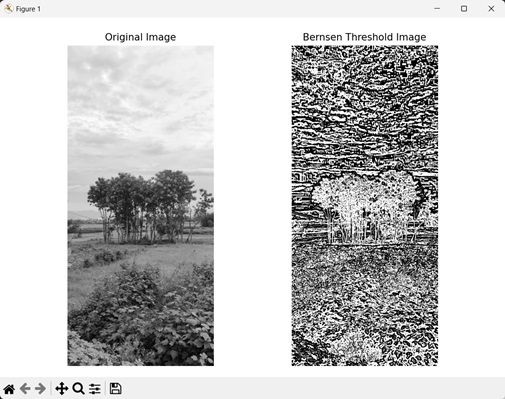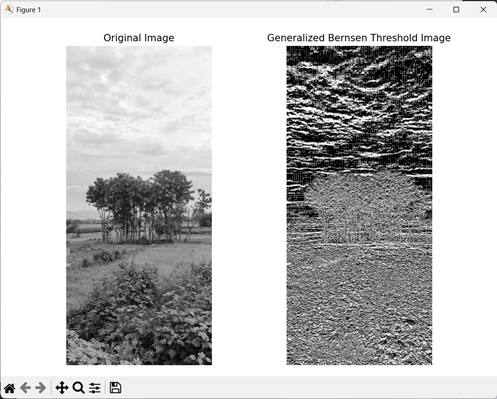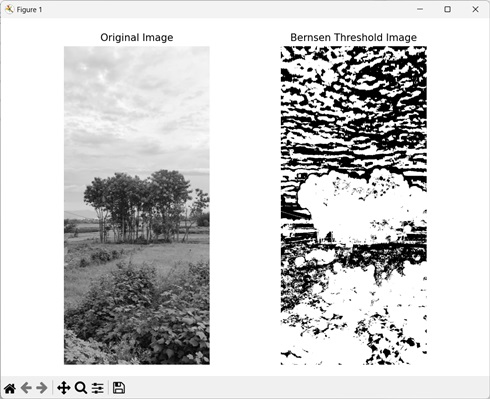Mahotas - Bernsen 局部阈值
Bernsen 局部阈值是一种将图像分割为前景和背景区域的技术。它使用局部邻域中的强度变化为图像中的每个像素分配阈值。
局部邻域的大小由窗口确定。较大的窗口大小在阈值处理过程中考虑更多相邻像素,从而在区域之间创建更平滑的过渡,但会删除更精细的细节。
另一方面,小窗口尺寸可以捕获更多细节,但可能容易受到噪声的影响。
Bernsen 局部阈值与其他阈值技术的区别在于,Bernsen 局部阈值使用动态阈值,而其他阈值技术使用单个阈值来分离前景和背景区域。
Mahotas 中的 Bernsen 局部阈值
在 Mahotas 中,我们可以使用 thresholding.bernsen() 和 thresholding.gbernsen() 函数对图像应用 Bernsen 局部阈值。这些函数创建一个固定大小的窗口,并计算窗口内每个像素的局部对比度范围以分割图像。
局部对比度范围是窗口内的最小和最大灰度值。
然后将阈值计算为最小和最大灰度值的平均值。如果像素强度高于阈值,则将其分配给前景(白色),否则将其分配给背景(黑色)。
然后将窗口移动到图像上以覆盖所有像素,从而创建二值图像,其中前景和背景区域根据局部强度变化分离。
mahotas.tresholding.bernsen() 函数
mahotas.thresholding.bernsen() 函数将灰度图像作为输入并对其应用 Bernsen 局部阈值。它输出一个图像,其中每个像素被分配一个值 0(黑色)或 255(白色)。
前景像素对应于图像中具有相对较高强度的区域,而背景像素对应于图像中具有相对较低强度的区域。
语法
以下是 mahotas − 中 bernsen() 函数的基本语法
mahotas.thresholding.bernsen(f, radius,contrast_threshold, gthresh={128})
其中,
f − 它是输入的灰度图像。
radius −它是每个像素周围窗口的大小。
contrast_threshold − 它是局部阈值。
gthresh(可选) − 它是全局阈值(默认值为 128)。
示例
以下示例显示了如何使用 mh.thresholding.bernsen() 函数对图像应用 Bernsen 局部阈值。
import mahotas as mh
import numpy as np
import matplotlib.pyplot as mtplt
# 加载图像
image = mh.imread('nature.jpeg')
# 将其转换为灰度
image = mh.colors.rgb2gray(image)
# 创建 Bernsen 阈值图像
threshold_image = mh.thresholding.bernsen(image, 5, 200)
# 创建子图的图形和轴
fig, axis = mtplt.subplots(1, 2)
# 显示原始图像
axes[0].imshow(image, cmap='gray')
axes[0].set_title('Original Image')
axes[0].set_axis_off()
# 显示阈值图像
axes[1].imshow(threshold_image, cmap='gray')
axes[1].set_title('Bernsen Threshold Image')
axes[1].set_axis_off()
# 调整间距子图
mtplt.tight_layout()
# 显示图形
mtplt.show()
输出
以下是上述代码的输出 −

mahotas.thresholding.gbernsen() 函数
mahotas.thresholding.gbernsen() 函数还将 Bernsen 局部阈值应用于输入灰度图像。
它是 Bernsen 局部阈值算法的通用版本。它输出一个分割图像,其中每个像素被分配一个 0 或 255 的值,具体取决于它是背景还是前景。
gbernsen() 和 bernsen() 函数之间的区别在于,gbernsen() 函数使用结构元素来定义局部邻域,而 bernsen() 函数使用固定大小的窗口来定义像素周围的局部邻域。
此外,gbernsen() 根据对比度阈值和全局阈值计算阈值,而 bernsen() 仅使用对比度阈值来计算每个像素的阈值。
语法
以下是 mahotas − 中 gbernsen() 函数的基本语法
mahotas.thresholding.gbernsen(f, se,contrast_threshold, gthresh)
其中,
f − 为输入灰度图像。
se − 为结构元素。
contrast_threshold − 为局部阈值。
gthresh(可选) −它是全局阈值。
示例
在此示例中,我们使用 mh.thresholding.gbernsen() 函数对图像应用广义 Bernsen 局部阈值。
import mahotas as mh
import numpy as np
import matplotlib.pyplot as mtplt
# 加载图像
image = mh.imread('nature.jpeg')
# 将其转换为灰度
image = mh.colors.rgb2gray(image)
# 创建结构元素
structuring_element = np.array([[0, 0, 0],[0, 0, 0],[1, 1, 1]])
# 创建广义 Bernsen 阈值图像
threshold_image = mh.thresholding.gbernsen(image, structuring_element, 200,
128)
# 为子图创建图形和轴
fig, axis = mtplt.subplots(1, 2)
# 显示原始图像
axes[0].imshow(image, cmap='gray')
axes[0].set_title('Original Image')
axes[0].set_axis_off()
# 显示阈值图像
axes[1].imshow(threshold_image, cmap='gray')
axes[1].set_title('Generalized Bernsen Threshold Image')
axes[1].set_axis_off()
# 调整子图之间的间距
mtplt.tight_layout()
# 显示图形
mtplt.show()
输出
上述代码的输出如下 −

使用平均值的 Bernsen 局部阈值
我们可以使用像素强度的平均值作为阈值来应用 Bernsen 局部阈值。它指的是图像的平均强度,计算方法是将所有像素的强度值相加,然后除以像素总数。
在 mahotas 中,我们可以先使用 numpy.mean() 函数找到所有像素的平均像素强度。然后,我们定义一个窗口大小来获取像素的局部邻域。
最后,我们将平均值传递给 bernsen() 或 gbernsen() 函数的 contrast_threshold 参数,将其设置为阈值。
示例
在这里,我们对图像应用 Bernsen 局部阈值,其中阈值是所有像素强度的平均值。
import mahotas as mh
import numpy as np
import matplotlib.pyplot as mtplt
# 加载图像
image = mh.imread('nature.jpeg')
# 将其转换为灰度
image = mh.colors.rgb2gray(image)
# 计算平均像素值
mean = np.mean(image)
# 创建 bernsen 阈值图像
threshold_image = mh.thresholding.bernsen(image, 15, mean)
# 创建子图的图形和轴
fig, axis = mtplt.subplots(1, 2)
# 显示原始图像
axes[0].imshow(image, cmap='gray')
axes[0].set_title('Original Image')
axes[0].set_axis_off()
# 显示阈值图像
axes[1].imshow(threshold_image, cmap='gray')
axes[1].set_title('Bernsen Threshold Image')
axes[1].set_axis_off()
# 调整子图之间的间距
mtplt.tight_layout()
# 显示图形
mtplt.show()
输出
执行上述代码后,我们得到以下输出 −



